Raphael - Paintings
In 1503, Raphael created an important painting, a Coronation of the Virgin, for the altar of the Franciscan Church in Perugia. The arrangement of the whole picture and types of figures are a manner of duplicate of his master, Perugino; but there appears something more intense, and a larger look which marks the beginning of another man.
In another painting, The Marriage of the Virgin (1504), there is but a duplication of the same story by Perugino. However, another meaning has filled it all, made another choice and build of architecture, changed here and there a little more and a little less of the details which were common property at that day.
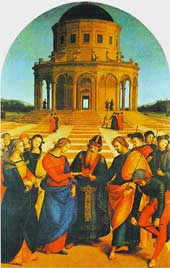
Raphael Sanzio
Marriage of the Virgin
Pinacoteca di Brera, Milan
The whole has a charm of simplicity and grace, which delights us today as if the idealistic presentation of a younger world. And one of the great qualities of his master and his companions remains attached to it; the notion of the picture being a place; a place set apart, a space within a space. So that the lines that make it, the gradations that fill it, are complete and do not suggest any extension outside of borders of the scene, as if seeing outside of the edge would disturb one's pleasure; later in the single figures and portraits of Raphael we shall feel this assertion of the picture; where his portrait ends, wherever the figure is cut, that is sufficient - we do not care for the part of it not represented - it never occurs to us to think of it.
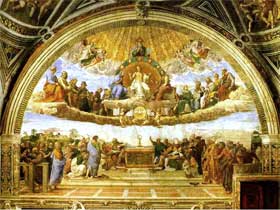
Raphael: Disputa
Vatican
After having worked at Siena, the young Raphael came up to Florence in 1504. Certainly the earlier paintings of Mother and Child, have the purity and the sweetness which the world knows. But during those four years in Florence, he painted a series of poems in honor of the Blessed Mother and her Child, in which he unfolded the bud to the full bloom of a perfect flower. His story, like that of Michelangelo, is that of a series of wonders, and that these few years should have been sufficient for the production of so much perfection is one of those wonders.
In Raphael's paintings, especially the Madonnas, the picture embodies an ideal of Sculpture: a certain pose contained within a certain shape; not a mere outline, but a mass of which we see one contour at a time. And in his painting, as we said above, he realized again a sculpture ideal, of one wishing to see no more than what we do, no more to either side, or above or below.
In 1508, Raphael went to Rome, and, under Pope Julius II. patronage, he begins the great wall paintings of the Vatican which are the full bloom of decorative art. He also paints portraits which surely, among Raphael's creations, remain the most prodigious representations of realistic study.
One of his most celebrated paintings is the portrait of the mighty Pope whose name is associated with Raphael and with Michelangelo. In the portrait we see the aged man burdened by life: we are in the presence of an energy and concentration enclosed within a certain dreaminess, that tell us what the man may be when called into the action of will or duty. The fresco in one of the Vatican rooms (Stanza d'Eliodoro) representing again the Roman Pontiff, conveys a single impression: It is the Pope. The face has the character of both the man and the office.
But before he came to this one of the later frescoes, Raphael had painted in another chamber (Stanza della Segnatura), the much more famous subjects which are known by the ultra-conventional names of The Dispute and The School of Athens. There is a great meaning in each of these pictures; a meaning suggested perhaps to Raphael or perhaps of his own finding. It matters not; for the meaning in art has to pass through the life of the maker.
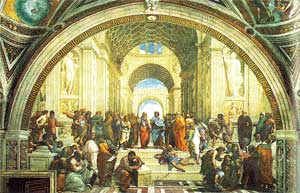
Raphael: School of Athens
Vatican
In the so-called Disputa we see the dream of a heaven opened, and Christ and God's law and the life of another world typified by grave and solemn beautiful human figures, seated far up beyond the clouds in a great dome that looks like the heavens. All these figures mean something, and they can be called by the names known to Christian faith, Mary, John, Adam, and Moses, and Paul, and Peter, and others nearer to us; and they have by them angels, lovely companions floating above them, in beautiful clouds, with wings and clothing to tell us what they are.
They are beautiful, and solemn, and majestic, and happy, and living some life like our own, but full of peace. Below on earth, solemn and splendid but anxious figures feel this presence and ask for a union with it. Popes, bishops, philosophers, thinkers of all kinds (Dante among them), stand or move with that common intention. They are all absorbed in the all powerful, wished-for truth.
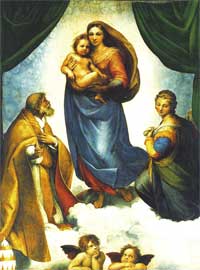
Raphael: Sistine Madonna
Gemäldegalerie, Dresden
The claims of Pure Thought, of the pursuit of Truth in Science, are typified in the paintings on the opposite wall. In an earthly palace, one of the finest dreams of the Renaissance, are placed here and there, as if in usual customary visit, representatives of what the age called the Seven Liberal Arts: Archimedes, Zoroaster, Ptolemy, Alcibiades, Socrates, Aspasia, Diogenes move about in the great light hall, through whose corridors advance toward us, surrounded and welcomed by illustrious thinkers, the representatives of two great paths of thought: two names most important to the men of that day, Plato and Aristotle.
A wonderful life fills all these figures, individually perhaps not more powerful than that of many a weaker work; but altogether, the flow of the crowd is not merely owing to the ingenious subtlety of the composition, nor to the beautiful arrangement of lines. All these things help; there is nothing wasted; the movements and gestures are increased and made more correct, apparently, by these subtleties, but there is still the imponderable quality that makes the essential of a dream.
Nothing is dependent on real exactness of attitude or of drawing. Hence, when others have tried, upon supposed lessons deduced from these great examples, they have failed. The formula becomes the formula of the theatre. That beautiful architecture which is a necessity for Raphael, as giving the meaning of the cloistered serenity of thought, becomes with imitation the arrangement of the wings of a stage.
The next Pope, Leo X. then displaces Julius in the great frescoes where he symbolizes the Papacy present in his person, at the events more or less historical, which the brush of Raphael or his assistants painted upon the walls. And again Raphael creates the portraits of the new Pope with that same perception that we recognize in the paintings representing Julius. He paints with great care and finish on the canvas as he paints with great ease and synthesis on the wall, and we see the character of another important man, the character of the intelligent, self indulgent heir of wealthy bankers and rulers, with no attempt at showing a deeper and inner life; for now the heroic days were over.
In only one direction do we feel that the harmonious charm of Raphael could not absorb the important beauty that he admired. The Sibyls, which he painted under the blow of Michelangelo's great figures, have no kin with them. They are graceful and beautiful, but they have not that story to tell which defines the movements and the build of the prophetic beings created by the Master of the Sistine Chapel. Raphael's prophecy was another one. There are limits to the powers of genius.
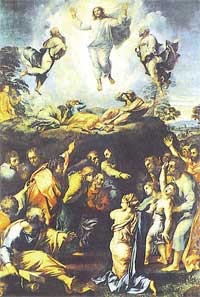
Raphael: The Transfiguration
Vatican
Another of the great Raphael's paintings, the Sistine Madonna, was executed between 1513 - 1514. He may have painted it in another mood, with another vision, in which for the last time, perhaps, he glorified that Mother and Child who had his very earliest love and preoccupation. The days of his personal work were drawing to a close. After 1517, his personal sharing in the painting is small. Nonetheless, the amount of work which he directed or prepared or retouched continued to increase.
Some of the best known paintings are painted in Raphael's last interval of continued stress of production. Perhaps the very last work shows, not fatigue, but that strange settling down into a given form which indicates for an artist the closing of a period. It is difficult for us to imagine what might have been the next great opening into some new field of perception. However noble some of the later work, a certain heaviness indicates perhaps the moment when the young man has definitely passed into a turn of mind that belongs to middle age.
In his last period, there is a change in Raphael's style, as in the last great painting of The Transfiguration. There is no loss of power. Indeed, the sense of mastery is as great as that expressed in his most energetic works. It is only perhaps that the suggestion of attainment seems to close the vista of a future.